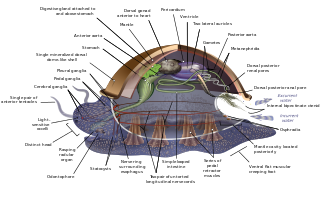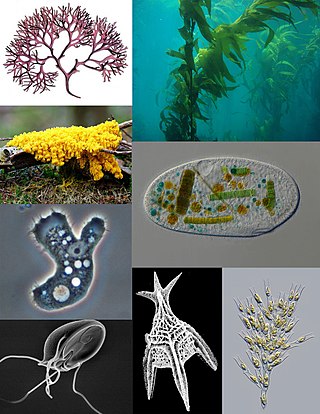Related Research Articles

The Cambrian Period is the first geological period of the Paleozoic Era, and of the Phanerozoic Eon. The Cambrian lasted 53.4 million years from the end of the preceding Ediacaran Period 538.8 million years ago (mya) to the beginning of the Ordovician Period 485.4 mya. Its subdivisions, and its base, are somewhat in flux.

An extinction event is a widespread and rapid decrease in the biodiversity on Earth. Such an event is identified by a sharp fall in the diversity and abundance of multicellular organisms. It occurs when the rate of extinction increases with respect to the background extinction rate and the rate of speciation. Estimates of the number of major mass extinctions in the last 540 million years range from as few as five to more than twenty. These differences stem from disagreement as to what constitutes a "major" extinction event, and the data chosen to measure past diversity.

Acritarchs are organic microfossils, known from approximately 1800 million years ago to the present. The classification is a catch all term used to refer to any organic microfossils that cannot be assigned to other groups. Their diversity reflects major ecological events such as the appearance of predation and the Cambrian explosion.

Dollo's law of irreversibility, proposed in 1893 by Belgian paleontologist Louis Dollo states that, "an organism never returns exactly to a former state, even if it finds itself placed in conditions of existence identical to those in which it has previously lived ... it always keeps some trace of the intermediate stages through which it has passed."
Joseph John Sepkoski Jr. was a University of Chicago paleontologist. Sepkoski studied the fossil record and the diversity of life on Earth. Sepkoski and David Raup produced a new understanding of extinction events, by developing a statistical approach to the study of taxonomic diversification. They suggested that the extinction of dinosaurs 66 mya was part of a cycle of mass extinctions that may have occurred every 26 million years. But their most important contribution was the identification of the "Big 5" mass extinctions, events that have shaped the evolution of life on earth.
In the geological timescale, the Tithonian is the latest age of the Late Jurassic Epoch and the uppermost stage of the Upper Jurassic Series. It spans the time between 149.2 ±0.7 Ma and 145.0 ± 4 Ma. It is preceded by the Kimmeridgian and followed by the Berriasian.

The timeline of human evolution outlines the major events in the evolutionary lineage of the modern human species, Homo sapiens, throughout the history of life, beginning some 4 billion years ago down to recent evolution within H. sapiens during and since the Last Glacial Period.

The evolution of the molluscs is the way in which the Mollusca, one of the largest groups of invertebrate animals, evolved. This phylum includes gastropods, bivalves, scaphopods, cephalopods, and several other groups. The fossil record of mollusks is relatively complete, and they are well represented in most fossil-bearing marine strata. Very early organisms which have dubiously been compared to molluscs include Kimberella and Odontogriphus.
Plotosaurus is an extinct genus of mosasaurs who lived during the Upper Cretaceous (Maastrichtian) in what is now North America. Only one species is recognized, P. bennisoni, described by Berkeley paleontologist Charles Lewis Camp in 1942 from fossils discovered in California. Originally named Kolposaurus, it was changed to Plotosaurus in 1951 when Camp discovered that the name had already been assigned to a type of nothosaur. Unlike other mosasaurids, Plotosaurus possesses a morphology converging with those of ichthyosaurs, suggesting a much more advanced swimming adaptation than some of its close relatives.

Paleobiology is an interdisciplinary field that combines the methods and findings found in both the earth sciences and the life sciences. Paleobiology is not to be confused with geobiology, which focuses more on the interactions between the biosphere and the physical Earth.
Louis Antoine Marie Joseph Dollo was a Belgian palaeontologist, known for his work on dinosaurs. He also posited that evolution is not reversible, known as Dollo's law. Together with the Austrian Othenio Abel, Dollo established the principles of paleobiology.

The Fort Union Formation is a geologic unit containing sandstones, shales, and coal beds in Wyoming, Montana, and parts of adjacent states. In the Powder River Basin, it contains important economic deposits of coal, uranium, and coalbed methane.
As understanding of the events of the Cambrian becomes clearer, data have accumulated to make some postulated causes for the Cambrian explosion look improbable. Some examples are the evolution of herbivory, vast changes in plate tectonic rates or orbital motion, or different evolutionary mechanisms in force.
The end-Ediacaran extinction is a mass extinction believed to have occurred near the end of the Ediacaran period, the final period of the Proterozoic eon. Evidence suggesting that such a mass extinction occurred includes a massive reduction in diversity of acritarchs, the sudden disappearance of the Ediacara biota and calcifying organisms, and the time gap before Cambrian organisms "replaced" them. Some lines of evidence suggests that there may have been two distinct pulses of the extinction event, one occurring 550 million years ago and the other 539 million years ago.

Mollusca is the second-largest phylum of invertebrate animals, after Arthropoda; members are known as molluscs or mollusks. Around 76,000 extant species of molluscs are recognized. The number of fossil species is estimated between 60,000 and 100,000 additional species. The proportion of undescribed species is very high. Many taxa remain poorly studied.
The climate across the Cretaceous–Paleogene boundary is very important to geologic time as it marks a catastrophic global extinction event. Numerous theories have been proposed as to why this extinction event happened including an asteroid known as the Chicxulub asteroid, volcanism, or sea level changes. While the mass extinction is well documented, there is much debate about the immediate and long-term climatic and environmental changes caused by the event. The terrestrial climates at this time are poorly known, which limits the understanding of environmentally driven changes in biodiversity that occurred before the Chicxulub crater impact. Oxygen isotopes across the K–T boundary suggest that oceanic temperatures fluctuated in the Late Cretaceous and through the boundary itself. Carbon isotope measurements of benthic foraminifera at the K–T boundary suggest rapid, repeated fluctuations in oceanic productivity in the 3 million years before the final extinction, and that productivity and ocean circulation ended abruptly for at least tens of thousands of years just after the boundary, indicating devastation of terrestrial and marine ecosystems. Some researchers suggest that climate change is the main connection between the impact and the extinction. The impact perturbed the climate system with long-term effects that were much worse than the immediate, direct consequences of the impact.
Paleontology or palaeontology is the study of prehistoric life forms on Earth through the examination of plant and animal fossils. This includes the study of body fossils, tracks (ichnites), burrows, cast-off parts, fossilised feces (coprolites), palynomorphs and chemical residues. Because humans have encountered fossils for millennia, paleontology has a long history both before and after becoming formalized as a science. This article records significant discoveries and events related to paleontology that occurred or were published in the year 2016.
Paleontology or palaeontology is the study of prehistoric life forms on Earth through the examination of plant and animal fossils. This includes the study of body fossils, tracks (ichnites), burrows, cast-off parts, fossilised feces (coprolites), palynomorphs and chemical residues. Because humans have encountered fossils for millennia, paleontology has a long history both before and after becoming formalized as a science. This article records significant discoveries and events related to paleontology that occurred or were published in the year 2019.

A protist is any eukaryotic organism that is not an animal, plant, or fungus. While it is likely that protists share a common ancestor, the last eukaryotic common ancestor, the exclusion of other eukaryotes means that protists do not form a natural group, or clade. Therefore, some protists may be more closely related to animals, plants, or fungi than they are to other protists. However, like algae, invertebrates and protozoans, the grouping is used for convenience.
Paleontology or palaeontology is the study of prehistoric life forms on Earth through the examination of plant and animal fossils. This includes the study of body fossils, tracks (ichnites), burrows, cast-off parts, fossilised feces (coprolites), palynomorphs and chemical residues. Because humans have encountered fossils for millennia, paleontology has a long history both before and after becoming formalized as a science. This article records significant discoveries and events related to paleontology that occurred or were published in the year 2022.
References
- ↑ "David Raup, paleontologist who transformed his discipline, 1933-2015". UChicago News. 14 July 2015. Retrieved 4 February 2017.
- ↑ "Pioneering cell biologist Hewson Swift, Ph.D., 1920-2004". www-news.uchicago.edu. Retrieved 4 February 2017.
- ↑ "CV: Charles R. Marshall" . Retrieved 15 May 2016.
- ↑ "UCMP welcomes Charles Marshall". UCMP newsletter. Retrieved 15 May 2016.
- ↑ Marshall, C.R. 1990. Confidence intervals on stratigraphic ranges. Paleobiology 16:1-10.
- ↑ Presentation of the Charles Schuchert Award of the Paleontological Society to Charles R. Marshall by Douglas Erwin
- ↑ Marshall C.R.; Ward P.D. (1996). "Sudden and Gradual Molluscan Extinctions in the Latest Cretaceous of Western European Tethys". Science. 274 (5291): 1360–1363. Bibcode:1996Sci...274.1360M. doi:10.1126/science.274.5291.1360. PMID 8910273. S2CID 1837900.
- ↑ Tavaré, S.; Marshall, C. R.; Will, O.; Soligo, C.; Martin R.D. (18 April 2002). "Using the fossil record to estimate the age of the last common ancestor of extant primates". Nature. 416 (6882): 726–729. Bibcode:2002Natur.416..726T. doi:10.1038/416726a. PMID 11961552. S2CID 4368374.
- ↑ Santiago R. Ramírez; Barbara Gravendeel; Rodrigo B. Singer; Charles R. Marshall; Naomi E. Pierce (30 August 2007). "Dating the origin of the Orchidaceae from a fossil orchid with its pollinator". Nature. 448 (7157): 1042–5. Bibcode:2007Natur.448.1042R. doi:10.1038/nature06039. PMID 17728756. S2CID 4402181.
- ↑ Marshall, C. R., et al. (1994). Dollo's law and the death and resurrection of genes. Proc Natl Acad Sci USA 91 12283.
- ↑ Marshall, C.R. (2006). "Explaining the Cambrian "Explosion" of Animals". Annu. Rev. Earth Planet. Sci. (abstract). 34: 355–384. Bibcode:2006AREPS..34..355M. doi:10.1146/annurev.earth.33.031504.103001. S2CID 85623607.